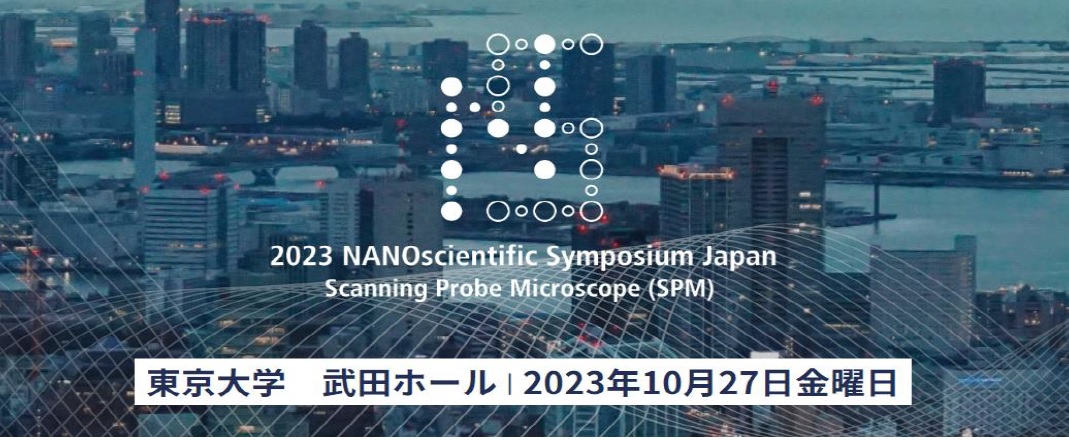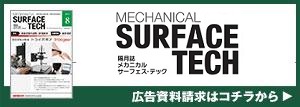ナノテクノロジーと走査型プローブ顕微鏡(SPM)に特化した「ナノ科学シンポジウム(NanoScientific Symposium Japan 2023 : NSSJ2023)」(https://event.nanoscientific.org/jp/2023)が10月27日10時~17時30分に、東京大学 浅野キャンパス 武田ホール(東京都文京区弥生2丁目11-16 武田先端知ビル5階:浅野正門入ってすぐ左手)での対面参加とオンライン参加からなるハイブリッド形式で開催される。
主催は関東学院大学材料・表面工学研究所とパーク・システムズ・ジャパンで、協賛はNanoScientificとヤマトマテリアル、Ark Station、後援は日刊工業新聞社とメカニカル・テック社。
シンポジウムHP(https://event.nanoscientific.org/jp/2023/registration)から参加登録できる。参加費は無料。

科学技術の革新によりナノ科学では材料、表面を計測・解析する方法も各種発展している。特に、SPMの登場により、 ナノレベルでの表面計測・解析の基礎技術としての重要性が日々増している。ナノ科学シンポジウム(NSSJ)は、走査型プローブ顕微鏡を用いた 材料科学、半導体およびライフサイエンス分野の最先端の研究情報を共有・交換するSPMユーザーシンポジウムで、今回のNSSJ 2023では、科学に変革をもたらすSPMの幅広い応用と技術に焦点を当て、先端技術のための新しいナノ材料、機能性表面、さらにナノテクノロジーやSPMを使った応用技術についても紹介する。
2020年から開催され4回目となる今回は、以下の登壇者による講演のほか、ポスター発表がなされる。
特別講演 タイトル未定
西 和彦氏(日本先端工科大学(仮称)設置準備委員会 特別顧問)
AFMナノインデンテーションによる1次元グラフェン歪み格子の作製
田中 悟氏(九州大学大学院工学研究院 教授)
グラフェンに歪み(勾配)を加えると擬磁場が発生する。擬磁場は電子の運動を仮想的に表す「場」であるが、実際の電子はあたかも磁場下にあるような運動を行う。この擬磁場を周期的に形成することにより、ランダウ量子化,更に(無磁場の)量子異常ホール効果の観察が期待されるが、そのためには1・2次元周期歪みグラフェンの形成が必要である。本発表では1次元歪み格子の実現のために、原子間力顕微鏡(AFM)ナノインデンテーションによるSiC表面への周期的ナノトレンチ構造の形成とグラフェン転写による歪みの導入を試みた結果を議論する。
SPM技術を用いた全固体電池の評価
富沢祥江氏(太陽誘電 開発研究所 材料開発部)
同社では発火や爆発の危険性が極めて少ない安全な全固体電池を開発している。全固体電池のサイクル特性やレート特性などの性能向上を図る上で、効率的かつ効果的な解析技術が不可欠である。全固体電池の詳細な動作解析を行う目的でSPM装置を導入した。SPM技術の中でもケルビンプローブフォース顕微鏡(KPFM)による電位分布評価は、電池を駆動させながら(operando計測)、電極内部の電位変化を可視化できるため、不良箇所を特定したり、正負各極の動作メカニズムを詳細に解明したりできる強力な手法である。本発表ではKPFM以外にも、SPMを活用した材料物性の評価事例、全固体電池デバイスの解析事例を紹介する。
3D Heterogeneous Integrated System Chip Technology
G.P. Li 氏(カリフォルニア大学 教授)
The combination of Internet of Things (IOT) and deep machine learning (AI) at edge is emerging as an universal solution in various industrial sectors. It is envisioned under IOT/AI that a new ecosystem will be established to transform fundamentally how human will interact with physical world, leading to truly industry revolution. Consequently, it promises a great potential to address and solve some of the challenges facing the world today such as resource and energy productivity, environmental sustainability, and demographic change. To enable such a future smart edge system, one needs to research physical mechanisms and mathematical algorithms for multi-sensor data fusion, to research manufacturing processes for implementation of the edge system, and to develop on-time and real-time prediction and adaptive control/learning. New 3D heterogeneous integrated system (HIS) chip engineering technologies will be explored in order to address these emerging demands in future smart edge systems.
In this talk, we will first describe the nature of the future smart edge system and its applications. Then a 3D heterogeneous integrated microchip technology architecture enabling AI is proposed. Manufacturing methods for designing, fabricating, and integrating sensing, wireless communication and AI in 3D HIS chip technology will be discussed for implementing smart cyber-physical-human-environment system as an intelligent platform for future edge system. 3D heterogeneous integrated system will also enable nanoelectronics beyond Moore’s integrated circuits paradigm, next generation of cyber physical edge intelligence science and technologies, and beyond human machine interaction. The proposed HIS chip technology will unite individual discipline research efforts into a 3D system with multiple functions mimicking holistic human cognitive functions in a technology platform.
薄膜デバイスにおける巨大磁気回転効果
能崎幸雄氏(慶應義塾大学 理工学研究科 教授)
マクロな回転運動から磁気を生み出す磁気回転効果は、約100年前にアインシュタイン、ドハース、バーネットによって発見された。しかし、キロヘルツオーダーの高速な回転運動でも地磁気程度の微弱な磁気しか生み出せなかったため、これまでその応用研究はほとんど行われてこなかった。講演者は、最新のナノテクノロジーを駆使することにより、薄膜デバイス内にギガヘルツオーダーの超高速な回転運動を生成し、巨大な磁気回転効果を生み出すことに成功した。当日は、磁気回転効果の基礎とその薄膜デバイス構造を概説し、磁気回転効果のデバイス応用についてその可能性を語る。
AFM Methodologies for Quality Assessment of Lithium-ion Battery Electrodes
Seong-Oh (Jake) Kim氏(Park Systems)
Lithium-ion based batteries (LIBs) are widely used as portable energy storage devices in various applications, including smartphones, laptops, and electric vehicles. Understanding the interplay between morphology and electronic properties at the nanometer scale is crucial for advancing the performance and quality control of LIBs.
This study provides a brief introduction to the basic principles of batteries and highlights the analysis of lithium-ion battery materials using Atomic Force Microscopy (AFM). The structure and composition of LIB electrodes, including active materials, conductive materials, and binders, are discussed. The role of active materials in the cathode and anode, and their impact on battery capacity and power, is highlighted. The challenges associated with volume changes and structural evolution of electrode materials during charge-discharge cycles are also addressed.
AFM is presented as a versatile platform for investigating the morphology and electrical properties of LIB materials at the micro- and nano-meter spatial resolutions. The ability of AFM to provide correlative information, including topography and electrical properties, such as resistance and local work function and the application of AFM in studying electrode materials for LIBs, including characterization of pristine materials, evaluation of electrode fabrication processes, and probing mechanical and electrical degradations caused by cycling, are highlighted. AFM is recognized as a valuable tool for gaining insights into the degradation mechanisms of LIBs and advancing the development of next-generation battery technologies.
ダイヤモンド半導体デバイスの作製とインチ径ウェハの成長メカニズム
嘉数 誠氏(佐賀大学大学院理工学研究科 教授)
ダイヤモンドはバンドギャップが5.47eVのワイドギャップ半導体で、絶縁破壊電界、熱伝導率、キャリア移動度が高く、シリコン、シリコンカーバイド(SiC)、窒化ガリウム(GaN)を超える大電力・高効率パワー半導体として期待されている。
講演者らは、875MW/cm2の出力電力(BFOM)を示すダイヤモンドMOSFETを作製した。オフ電圧は3659Vである。この素子は、NO2を用いたp型ドーピングと低温堆積Al2O3膜によるパッシベーションの独自技術を用いている。
また、ダイヤモンドウェハは、2インチ径まで大口径化が進んでいる。サファイア基板とMgO基板を用いた場合を比較し、ダイヤモンドの初期成長表面をAFMで観察し、結晶品質を決める成長機構を調べた。
半導体光デバイスと通信・センサーへの応用
荒川太郎氏(横浜国立大学 理工学部 数物・電子情報系学科 教授)
半導体レーザーをはじめとする半導体光デバイスは、光ファイバー通信、センシング、分光分析、加工、医療・バイオなど様々な分野に応用されており、光エレクトロニクスと呼ばれる工学分野の中心を担っている。化合物半導体光デバイスは主にレーザーや発光ダイオード、光変調器、光スイッチなど能動素子として使用されている。シリコン光デバイスも発光素子を除く能動・受動素子として使用されており、いずれの場合も半導体が重要な役割を果たしている。
本講演では、これまで講演者らが研究・開発してきた化合物半導体およびシリコン光デバイスを中心に、それらの動作原理と光ファイバー通信やバイオセンサー・ガスセンサーへの応用例を紹介する。
AFMによる粘弾性計測の最新の展開
中嶋 健氏(東京工業大学 物質理工学院 教授)
AFMを用いて粘弾性計測を行う試みにはいくつかの方法がある。
本講演ではそれらについて概観するとともに、特に貯蔵弾性率・損失弾性率などを画像化できるナノ粘弾性計測手法(nanoDMA)について、原理と最新の展開を紹介する。例えば、フィラーと高分子マトリックスからなるナノコンポジットの界面の粘弾性について、マトリックスがゴム状態にある場合とガラス状態にある場合で界面の振る舞いが異なっている。それを可視化した最近の論文について詳しく取り扱う。






